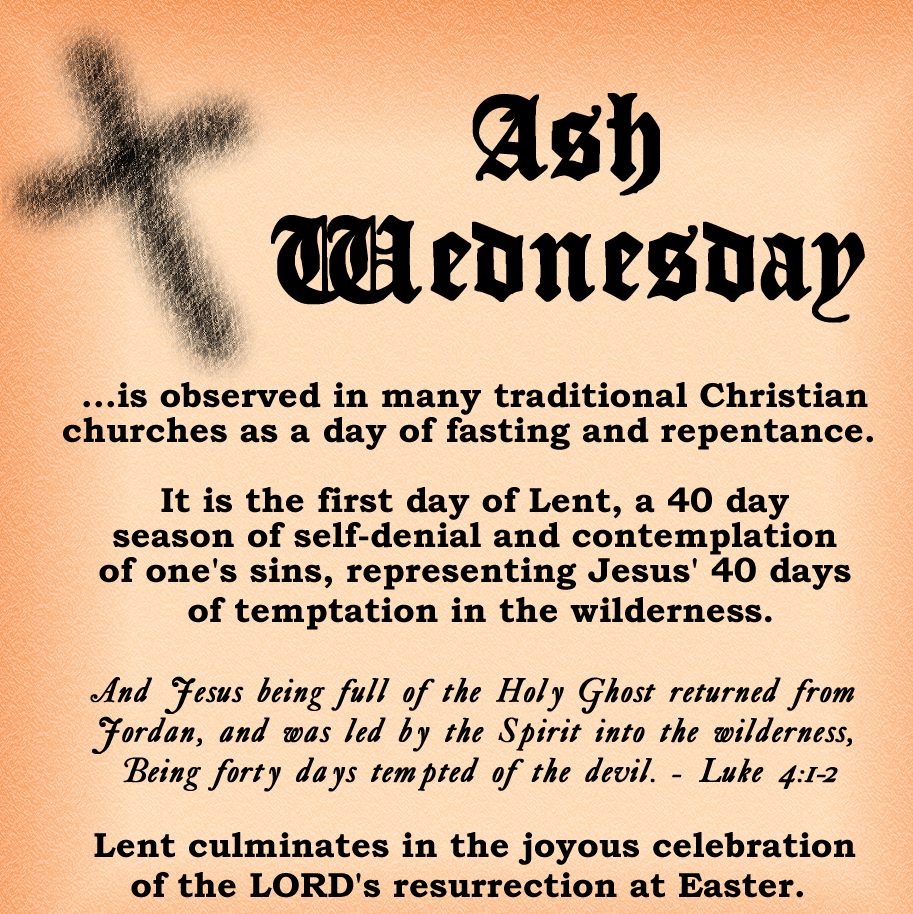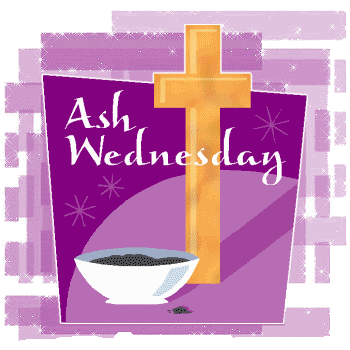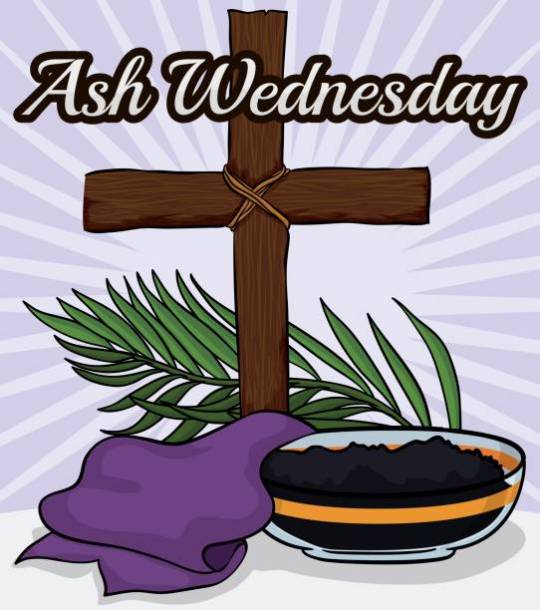

Ash Wednesday is a Christian holy day of prayer, fasting, and repentance. It is preceded by Shrove Tuesday and falls on the first day of Lent, the six weeks of penitence before Easter.
 Ash Wednesday is observed by many Christians, including Anglicans, Episcopalians, Lutherans, Old Catholics, Methodists, Presbyterians, Roman Catholics, and some Baptists.
Ash Wednesday is observed by many Christians, including Anglicans, Episcopalians, Lutherans, Old Catholics, Methodists, Presbyterians, Roman Catholics, and some Baptists.


Ash Wednesday derives its name from the placing of repentance ashes
on the foreheads of participants to either the words "Repent, and
believe in the Gospel" or the dictum "Remember that you are dust, and to
dust you shall return." The ashes may be prepared by burning palm leaves from the previous year's Palm Sunday celebrations.


Because it is the first day of Lent, many Christians, on Ash Wednesday, often begin marking a Lenten calendar, praying a Lenten daily devotional, and abstaining from a luxury that they will not partake in until Easter Sunday arrives.

Observances
Fasting and abstinence
Many Christian denominations emphasize fasting, as well as abstinence during the season of Lent and in particular, on its first day, Ash Wednesday. The First Council of Nicæa spoke of Lent as a period of fasting for forty days, in preparation for Eastertide.
In many places, Christians historically abstained from food for a whole
day until the evening, and at sunset, Western Christians traditionally
broke the Lenten fast, which is often known as the Black Fast.

In India and Pakistan,
many Christians continue this practice of fasting until sunset on Ash
Wednesday and Good Friday, with some fasting in this manner throughout
the whole season of Lent.
In the Roman Catholic Church, Ash Wednesday is observed by fasting, abstinence from meat, and repentance – a day of contemplating one's transgressions. On Ash Wednesday and Good Friday,
Roman Catholics between the ages of 18 and 59 (whose health enables
them to do so) are permitted to consume one full meal, along with two
smaller meals, which together should not equal the full meal. Some
Catholics will go beyond the minimum obligations put forth by the Church
and undertake a complete fast or a bread and water fast until sunset.
Ash Wednesday and Good Friday are also days of abstinence from meat
(mammals and fowl), as are all Fridays during Lent. Some Roman Catholics continue fasting throughout Lent, as was the Church's traditional requirement, concluding only after the celebration of the Easter Vigil.
Where the Ambrosian Rite is observed, the day of fasting and abstinence
is postponed to the first Friday in the Ambrosian Lent, nine days
later.

A number of Lutheran parishes teach communicants to fast on Ash
Wednesday, with some people choosing to continue doing so throughout the
entire season of Lent, especially on Good Friday. One Lutheran congregation's A Handbook for the Discipline of Lent
recommends that the faithful "Fast on Ash Wednesday and Good Friday
with only one simple meal during the day, usually without meat".
In the Church of England, and throughout much of the Worldwide
Anglican Communion, the entire forty days of Lent are designated days
of fasting and abstinence in the 1662 Book of Common Prayer, with the Traditional Saint Augustine's Prayer Book: A Book of Devotion for Members of the Anglican Communion
defining "Fasting, usually meaning not more than a light breakfast, one
full meal, and one half meal, on the forty days of Lent." The same text defines abstinence as refraining from flesh meat on all Fridays of the Church Year, except for those during Christmastide.

The historic Methodist homilies regarding the Sermon on the Mount stress the importance of the Lenten fast, which begins on Ash Wednesday. The United Methodist Church therefore states that:
There is a strong biblical base for fasting, particularly during the 40
days of Lent leading to the celebration of Easter. Jesus, as part of his
spiritual preparation, went into the wilderness and fasted 40 days and
40 nights, according to the Gospels.

Ashes are ceremonially placed on the heads of Christians on Ash
Wednesday, either by being sprinkled over their heads or, in
English-speaking countries, more often by being marked on their
foreheads as a visible cross. The words (based on Genesis 3:19) used traditionally to accompany this gesture are, "Memento, homo, quia pulvis es, et in pulverem reverteris." ("Remember, man, that thou art dust, and to dust thou shalt return.") This custom is credited to Pope Gregory I the Great (c. 540–604). In the 1969 revision of the Roman Rite, an alternative formula (based on Mark 1:15)
was introduced and given first place "Repent, and believe in the
Gospel" and the older formula was translated as "Remember that you are
dust, and to dust you shall return." The old formula, based on the words
spoken to Adam and Eve after their sin, reminds worshippers of their sinfulness and mortality and thus, implicitly, of their need to repent in time. The newer formula makes explicit what was only implicit in the old.

Various manners of placing the ashes on worshippers' heads are in use within the Roman Rite of the Catholic Church,
the two most common being to use the ashes to make a cross on the
forehead and sprinkling the ashes over the crown of the head.
Originally, the ashes were strewn over men's heads, but, probably because women had their heads covered in church, were placed on the foreheads of women. In the Catholic Church the manner of imposing ashes depends largely on local custom, since no fixed rule has been laid down.

 Although the account of Ælfric of Eynsham shows that in about the year 1000 the ashes were "strewn" on the head, the marking of the forehead is the method that now prevails in English-speaking countries and is the only one envisaged in the Occasional Offices of the Anglican Church of Papua New Guinea, a publication described as "noticeably Anglo-Catholic in character".
Although the account of Ælfric of Eynsham shows that in about the year 1000 the ashes were "strewn" on the head, the marking of the forehead is the method that now prevails in English-speaking countries and is the only one envisaged in the Occasional Offices of the Anglican Church of Papua New Guinea, a publication described as "noticeably Anglo-Catholic in character".
In its ritual of "Blessing of Ashes", this states that "the ashes are blessed at the beginning of the Eucharist; and after they have been blessed they are placed on the forehead of the clergy and people." The Ash Wednesday ritual of the Church of England, Mother Church of the Anglican Communion, contains "The Imposition of Ashes" in its Ash Wednesday liturgy.
 On Ash Wednesday, the Pope, the Bishop of Rome, traditionally takes part in a penitential procession from the Church of Saint Anselm to the Basilica of Santa Sabina,
where, in accordance with the custom in Italy and many other countries,
ashes are sprinkled on his head, not smudged on his forehead, and he
places ashes on the heads of others in the same way.
On Ash Wednesday, the Pope, the Bishop of Rome, traditionally takes part in a penitential procession from the Church of Saint Anselm to the Basilica of Santa Sabina,
where, in accordance with the custom in Italy and many other countries,
ashes are sprinkled on his head, not smudged on his forehead, and he
places ashes on the heads of others in the same way.
Originally, the ashes were strewn over men's heads, but, probably because women had their heads covered in church, were placed on the foreheads of women. In the Catholic Church the manner of imposing ashes depends largely on local custom, since no fixed rule has been laid down.


In its ritual of "Blessing of Ashes", this states that "the ashes are blessed at the beginning of the Eucharist; and after they have been blessed they are placed on the forehead of the clergy and people." The Ash Wednesday ritual of the Church of England, Mother Church of the Anglican Communion, contains "The Imposition of Ashes" in its Ash Wednesday liturgy.




No comments:
Post a Comment